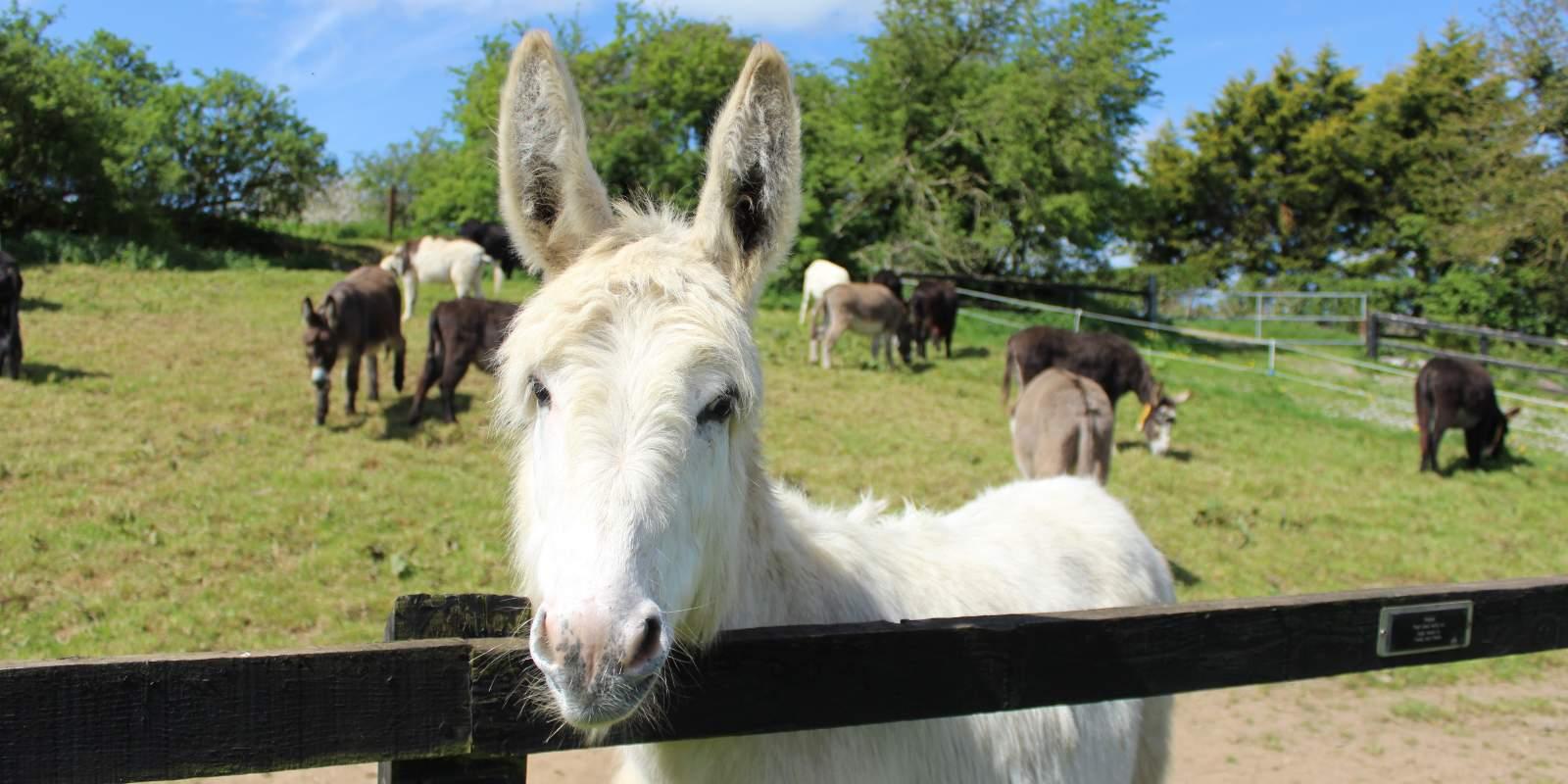
If you have just embarked on a new adventure and welcomed a donkey to your family, it can be very rewarding. However there are several points to consider when taking donkeys into your care.
Unless you intend to breed donkeys, you should not have a stallion. Stallions by their nature can be extremely unpredictable, especially if there is a mare in season nearby. Geldings (castrated stallions) and mares both have their own behaviour traits; playful geldings may romp and fight like schoolboys, whereas mares come into season and need more understanding handling at this time. A pair of donkeys of the same sex will be just as happy as a mare and gelding combination.
Donkeys commonly "pair bond" and this can lead to problems if trying to separate them from their companion, which may not necessarily be another donkey. Do not separate bonded pairs as it can lead to stress. If the donkey's companion has to be put to sleep always ensure that the remaining donkey is allowed to spend time with the body so that they can come to terms with the death. If the donkey is removed and put to sleep away from his friend the remaining donkey may become extremely stressed.
It is certainly the experience of The Donkey Sanctuary and elsewhere that surviving companions must be allowed time with the body of their deceased friend. Ignoring this advice can lead to significant distress and anxiety amongst any surviving donkeys. They may show persistent wandering, pacing and braying, as they look for the missing donkey. Some individuals may even become ill if their appetite is depressed by this repetitive behaviour. As a guide, an hour is usually sufficient, or the time it takes for the surviving donkeys to return to their normal calm behaviour and feeding pattern.
Always allow the donkey(s) to share a stable with their companion. Allow approximately 4.5 square metres of covered area per donkey, approximately 9 square metres for a pair. Unlike a horse, donkeys do not have a natural build up of grease to make their coat waterproof, so they should always have access to a shelter or stable.
Donkeys do not exhibit the same signs of pain as a horse or pony; be aware of, and react to, changes to their normal behaviour patterns. If a donkey is refusing food, and/or becomes distressed or lame, call a veterinary surgeon immediately. For both the new and experienced donkey owner, it is certainly advisable to use the following five-point check list on a daily basis:
- Behaviour
- Appetite and thirst
- Faeces and urine
- Eyes, nose and resting respiration (breathing)
- Coat and skin.
A donkey's normal temperature is not the same as a horse or pony. Adult donkeys range from 36.2ºC to 37.8ºC.
Donkeys suffer from hyperlipaemia with fat donkeys being especially at risk. Hyperlipaemia is brought on by stress. When donkeys stop eating enough, fat is mobilised into their blood stream to be converted to glucose by the liver. This process is regulated by complex hormones, which in small ponies and donkeys does not shut off efficiently. Large amounts of excess fat can cause the donkey's liver and kidneys to degenerate and fail. Stress can be caused by pain, travelling, change of diet, change of environment or loss of a companion. Hyperlipaemia can be fatal and early veterinary intervention is required. Symptoms include loss of appetite and depression. If your donkey appears unwell or stops eating call your veterinary surgeon.
Donkeys require a diet low in protein, sugar and starch, but high in fibre. For this reason, the basis of their diet should be barley straw all year round with a restricted amount of grass. In winter the grass may need to be supplemented with small amounts of hay. Overweight donkeys are at risk from laminitis and hyperlipaemia. Old or sick donkeys may require supplements to this diet; your veterinary surgeon can help with this and the Sanctuary has more advice available on feeding donkeys.
Basic rules of feeding:
- Feed little and often, donkeys are 'trickle feeders'
- Any change in the feeding regime must always be carried out gradually over at least 14 days
- Always feed according to the donkey's age, weight and temperament
- Avoid dusty or mouldy feeds
- Always have clean water available
- Access to an equine salt or mineral lick is advisable.
Most donkeys will become obese on unrestricted grazing. The sensible use of electric/moveable fencing will enable you to control your donkey's grass intake. Electric tape systems are preferable to wire as they are more visible. Always follow the manufacturer's guidelines. Keep your fence neat and well maintained and check it every morning and evening, moving as appropriate. The rotation of grazed areas can also be very useful in helping to control parasitic worms.
Barley straw is the preferred bedding for healthy donkeys. Barley straw is lower in feed value than oat straw, but higher than wheat straw. It is comfortable for the donkeys to lie on and drains reasonably well. If barley straw is not available it is acceptable to use oat or wheat straw. Straw is the cheapest form of bedding. If donkeys have respiratory problems or require dieting then, having consulted your veterinary surgeon, a dust free, particle bedding should be used. Donkeys suffering from respiratory illness will need to be fed an alternative to barley straw.
Donkeys require a floor level feed bin or corner floor feeder, situated to prevent feed being soiled. Small hole haynets can be used with donkeys, but should be tied at a comfortable height to avoid lifting the head too high, but also not so low that the donkey is at risk of getting tangled up in it. Place enough straw in the feeder so that they can browse through it; there will be no waste as the remainder can be used for bedding. If possible, position the feeder so that the donkey's feet are not on the bedding while they are eating, so they have a chance to dry out. In the winter you may need to add a small amount of hay to the straw in the feeder if your donkeys are not maintaining their body condition with the grass and straw-based diet.
Be aware of the risks of laminitis from excessive consumption of grass or cereal grain-based feeds (stressed grass ie frosty conditions can also increase the threat of laminitic attack.) Donkeys are particularly at risk of this condition during the spring and autumn when the grass is rich and growing quickly. Fields which have been previously fertilised may pose a greater threat. Spring and autumn, however, are not the only 'risk periods'. Whenever grass is growing well it may be a potential problem.
Donkeys should always have access to a clean water supply; they are very fussy about what they drink. A securely supported bucket or a self-filling trough should be constantly available and should be cleaned out daily after the stable has been mucked out to avoid a build-up of dust or dirt in the water.
Get to know your donkey's feet. Pick them up and remove all the muck and stones daily. Find a farrier who regularly trims donkeys' feet; ask him to visit every 6-10 weeks. If your donkey has specific problems they may require more frequent visits.
Transport donkeys loose, wearing a head collar. Do not tie them up; they prefer to find their own balance. Keep bonded donkeys with their companions in the box; do not split them with a partition. Donkeys that are lame, have overgrown hooves, are over 30 years old, in poor condition, very overweight or under veterinary treatment must not be transported without a certificate of fitness to travel, which is issued by a veterinary surgeon.
Free advice and support on caring for donkeys is provided by contacting our welfare team. The Donkey Sanctuary also has a dedicated team of welfare advisers throughout the UK who provide help to donkey owners, free of charge and run donkey care workshops nationwide.
Further information
